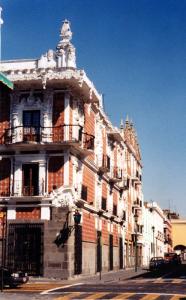Mexico
Oaxaca
As soon as my flight landed in Mexico City, I found a bus that left
from the airport to go to Puebla, spent the night there, then took a
second bus to Oaxaca City in the morning. I never want to deal with huge
capital cities on the first days of my vacations.
Oaxaca (the capital of the state of the same name) is a moderately
large colonial city packed with tourists around the Zocolo. For me,
the two most memorable things were the food and the folkcrafts.

| Oaxaca has a huge per capita consumption of chocolate.
Chocolate is native to Mexico, but it was the Spaniards who
added sugar to it.
It is frequently drunk hot (and sometimes cold) and is an
essential ingredient in some of the ubiquitous mole sauces,
especially the black (or Oaxaqueño) mole.
A large portion of Oaxacan chocolate appears to be processed
on Calle Mina, just a couple of blocks south of the Zocolo.
As one walks by, the smell of freshly-ground cocoa beans is
unmissable. Customers specified the desired proportions of
cocoa beans, sugar, almonds, and cinnamon, and one of the
molinos would grind it, as shown on the left. All
the ingredients but the sugar are thrown into the top of the
mill, and a brown chocolate sludge fell into the waiting heap
of sugar below, which would be rapidly mixed with a metal
scraper by the mill operator. The grinders, especially those
at Chocolate Mayordomo, were very busy in the mornings.
Slightly less popular were the mills used to blend the
ingredients for mole. These mills were in separate storefronts,
possibly to spare the chocolate customers from inhaling the
freshly-ground dried chiles.
|
|
The southeast corner of Oaxaca state, featuring the cities of
Tehuacan and Juchitán, are culturally distinct from
the state capital. It is known as the isthmus because
it is the narrowest part of Mexico, and high winds result from
the proximity of the Gulf of Mexico to the Pacific Ocean.
The land is much lower, so it has
a more tropical feel. There were mangoes, pineapples, and
iguanas in abundance. I was told by a
local that iguanas taste like chicken.
I went to the market to try iguana and saw lots of them
stewed with tomatoes. The unfortunate result looked like chopped-up
bright green and gray rubber lizards tossed into a pot of
stewed tomatoes. I would rather not eat things that look so
reptilian, so I decided to have chicken for lunch instead,
which I understand tastes a lot like iguana.
| 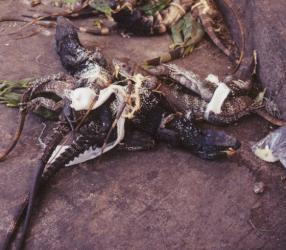
|
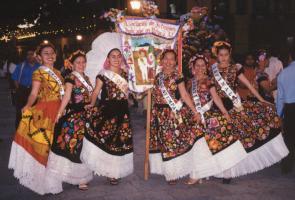
|
The isthmus is known for being matriarchal,
and the women of the region are known as tehuanas.
Frida Kahlo adopted tehuana dress in many of her paintings.
The older women wore embroidred huipils or floral-print blouses
and skirts. For special occasions, the women wore intricately-embroidered
dresses and blouses that could cost hundreds of dollars.
Formal wear for men was a white guayabera shirt and black pants.
The women shown here happen to be in Oaxaca City for an
Istmeña celebration.
|
Puerto Escondido
I headed down to Puerto Escondido on the Pacific coast of Oaxaca,
for the celebration for the Virgen de Soledad, the patron
saint of Oaxaca and fishermen. The celebrations take place from
December 16th to the 18th every year. At around 1:30am on December 17th,
I heard the church bells clang wildly. The church was right across
the street from my hotel, so I got dressed and went down.
Large paper mache figures of George W. Bush, Osama bin Laden, and a
woman who was presumably the Virgin danced around to the raucous
sounds of a brass band playing what sounded suspiciously like
German polkas. Lots of townspeople were milling about or dancing
behind the church to another large brass band.
About half an hour later everyone dispersed, and I was left wondering
why everyone would get up in the middle of the night to celebrate
for just half an hour.
| On the evening of December 17th, Puerto Escondido had a
torito, in which a stick-and-paper bull was loaded with
fireworks and a young man would charge around the crowds with it.
The bull would go quiet for a few moments, during which the braver
children approached, then the fuse would hit another round of
explosives, and the bull would emit a loud round of sparks and
flame, scaring away the children. They also had a
Castillo, which is a tall bamboo
structure (perhaps four stories high), on which were mounted
rings of fireworks that spun when lit.
| 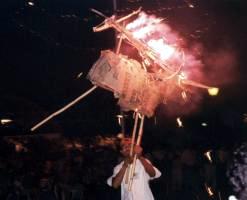
|
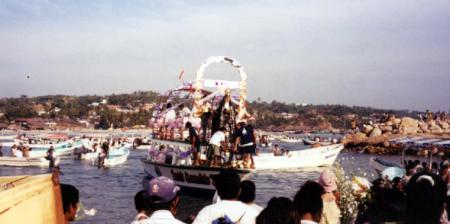
|
On the evening of the 18th, the statue of the Virgin of
Solitude was taken from her central place in the town church and placed
on a small boat, which was followed out to sea by a procession
of brass bands and the faithful in small launches. She returned
to shore an hour later, and after she was placed back in her altar
there was a long mass in the church.
|
| The main reason people go to Puerto Escondido is for the
beach. The beach right by the town looked crowded and a bit
dirty, but a 20-minute walk got me to Carrizalillo,
a calm, beautiful bay perfect
for relaxing at one of the palapas or surfing.
The beach is more crowded than it appears in this photo, and
palapas lined the back edge of the beach to serve drinks
and seafood. However, there were far fewer roving vendors
than at other beaches,
probably because the only access to this bay is a steep and
narrow footpath.
| 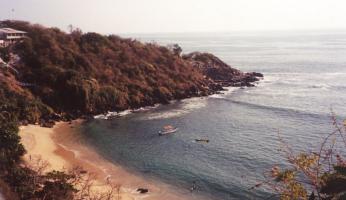
|
Veracruz
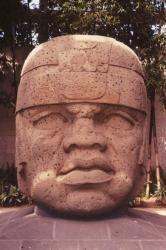
| I was impressed by the music, food, and archaeology of the state
of Veracruz. The Veracruz region was the center of the Olmec culture,
which produced wonderful sculptures, most famously the giant basalt
heads. The one on the left was at the excellent anthropology museum
in Xalapa, the state capital.
|
| The best coffee in the country may be at the Gran Cafe La Parroquia,
in the city of Veracruz. The most popular drink was the lechero,
which is basically a latte. They give you a tall glass with a
shot of thick coffee on the bottom, and you tap your spoon against the
glass to get the attention of one of the roving waiters who will fill
the rest of the glass with hot milk.
I believe that the famous restaurant was once named Cafe Gran Portal
and was on the Zocolo, but there was a rift in the family that owned it.
One side got the name and the location, and the other side got the
coffee machines and moved to the malecon.
| 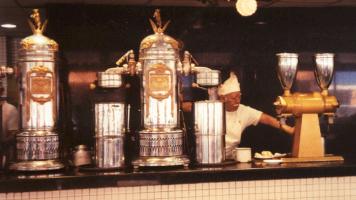
|
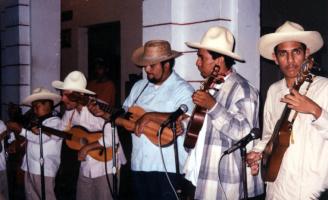
| The regional folk music was fantastic. The mix of Mexican and
Caribbean culture produced jarochos, centered just a bit south
of the city of Veracruz. The music is lively, and the
most famous son jarocho is La Bamba, popularized by Richie Valens.
|
| Standard jarocho dress for men is a white guayabera shirt,
white pants, a red bandana around the neck, and a hat with four indentations.
Traditional dress for women is a white dress, a colored apron and shawl,
and a fan slung around the neck. This photo is from a performance in
Tlacotalpan.
| 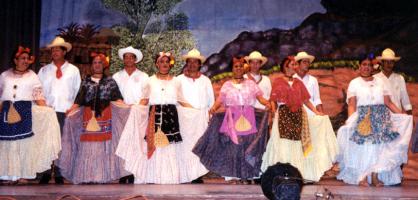
|
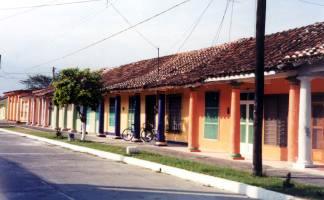
| Tlacotalpan is a lovely little town south of the city of Veracruz.
The whole town was declared a
UNESCO World Heritage Site
in 1998.
The houses and shops were mostly colonaded and brightly-painted.
There was hardly anything over one story high.
This was the only town I encountered that had no internet access,
and I also could not find a newspaper or magazine shop.
I believe that they suffer frequent floods from the river that runs
along the side of the town.
It is the setting of the movie
Santitos.
|
Gran Cafe La Parroquia Gomez Farias No. 34
Museo de Antropologia (Av. Jalapa y Acueducto; daily except Monday, 9:00am - 5:00pm; N$15 / US$1.50, free on Sundays)
La Churreria del Recuerdo - Calle Guadalupe Victoria No. 158 - churros and cena
Puebla
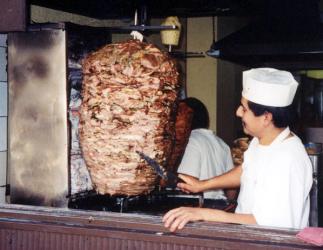
| Due to the large immigrant Lebanese population, vertical spit
rotisseries are popular in Mexico. This man is slicing thin strips of meat
for tacos arabe.
|
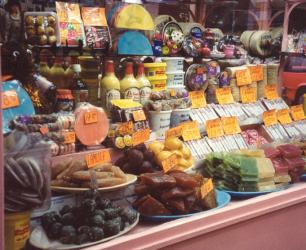
| Puebla is famous for its candy.
Most common are candied vegetables (such as squash and
oranges) and camotes, which are sweet potato mixed with sugar
and fruit flavor.
|
Mexico City
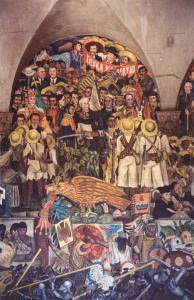
| There was a lot of evidence from the lives of Diego Rivera and
Frida Kahlo in Mexico City. Diego's murals were all over the city.
This one is at the Palacio on the Zocolo.
|
| This is the 1930's home of Diego and Frida designed by
Juan O'Gorman. It consists of two separate houses connected
by a bridge. The blue one on the right is Frida's and the other
is Diego's.
I understand that both of them had many affairs.
The house(s) is now a museum that features some of O'Gorman's
architectural drawings and photos as well as a few rooms
preserving the personal effects of Diego's and Frida's.
|
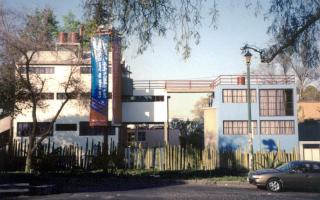
|

| Another view of Frida's half of the O'Gorman house and the
surrounding cactus fence.
|
| Perhaps the holiest place in Mexico is the Nuestra Bascilica
de la Señora de Guadalupe.
In the 16th century, Juan Diego, an indigenous Christian convert,
saw the Virgin Mary on a hill near Mexico City.
The Virgin asked him to tell the Bishop to build a church for
her on the hill. The Bishop did not believe him and demanded
proof.
The fearful Juan Diego returned to the hill days later and
told the Virgin about his meeting with the Bishop.
The Virgin instructed him to gather up the roses blooming
before her in the cold of winter as a sign.
When he returned to the church with the roses, the authorities
saw the image of the Virgin emblazoned on his cloak.
The Virgin has mestizo features, with
characteristics of European and indigenous people.
The cloak is now in the Nuestra Bascilica de la Señora de Guadalupe.
| 
|
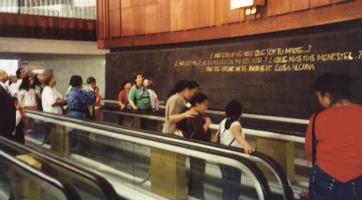
| In front of the cloak were four people-movers,
presumably to keep the faithful from spending all day in front of
the sacred image.
|
| The cake showroom of the Ideal Pasteleria in Mexico City.
These cakes appear to be for Quinceañeras and other
festive occasions. Around the corner were dozens of giant
completely white cakes for weddings. Walking into that
section was like entering a blizzard - I was blinded by the
white walls and whiter icing. Another section showcased
children's cakes, which are a bit smaller and featured
cartoon characters. I can not figure out how these cakes
are transported - the layers must come apart, but there is
so much icing under each layer that I suppose that it
must be done on-site.
| 
|
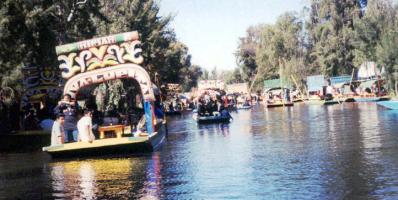
| Xochomilco is a suburb south of Mexico City and is yet another
UNESCO World Heritage Site.
It is famous for its canals. My family and I went there on January
1st because most of the shops and museums in Mexico City were closed
that day.
Boats and an oarsman were hired at one of the many docks, and you are
taken on the canals, which are jammed with other tourists and merchants
in boats trying to sell them things. Some of the boats were full of
mariachis, which would pull along side a passenger boat and perform a
few songs for a price. Many sold cold beer or hot corn.
Xochomilco is known for its nurseries, and some passenger boats pulled
up to the canalside ones to buy plants.
|
Angangueo
All of the monarch butterflies east of the Rockies in the
United States and Canada migrate to a small forest in central
Mexico near the village of Angangueo.
There were trucks for hire in Angangueo that would drive you
up to El Rosario butterfly reserve, wait two hours, then take
you back to the village for 350 pesos per truckload of passengers.
I decided to try walking up with another American tourist.
After a few tiring minutes of hiking up the steep hill at half past
seven in the morning, a flatbed truck stopped and invited us to hop on.
We gave the driver about twenty pesos when he dropped us off at
a fork in the road near the top of the hill, and we walked the
remaining flat stretch to the sanctuary.
| Guides are required once you enter El Rosario. A non-English
speaking guide accompanied us up the forested path. The path had
a handful of sleeping or dead monarchs on it, which the guide
carefully picked up and tossed on the side where they wouldn't
be trampled by early tourists.
Near the top of the hill, trees were nearly completely covered with
sleeping monarch butterflies. Because their wings were closed, they
looked like dull brown dead leaves. As the sun warmed them, they
awakened and flew off. The guide books suggest arriving early
in the morning, but I think it would have been more interesting to
see more of the monarchs in the air, perhaps around noon.
| 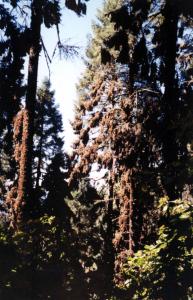
|
Tepoztlán
| Tepoztlán is a little over an hour south of Mexico City and
is a weekend resort for those wishing to escape the city.
It is a tiny town with cobblestone streets and low buildings.
On weekends, the streets are packed with stalls selling hippie
jewelry and Asian crafts to cater to the young visitors.
For the rest of the week, the stalls are gone and many of the
restaurants are closed.
The most famous shop may be Tepoznieves, which serves
the best sorbet (nieves) I had in Mexico.
They had the usual (and unusual) fruit flavors, but also featured
strange (such as figs in mescal, celery, and pine nut) and cryptic
(Kiss of an Angel, Dream of the Sirens) varieties.
There were three shops packed around the center of town.
| 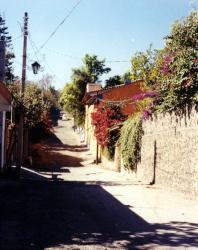
|
| The Ex-Convento Domínico de la Natividad
is in the center of town.
The walls are covered with recently-restored murals.
| 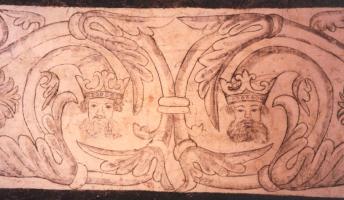
|
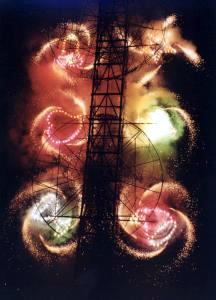
| I was in Tepoztlán during the Día de los Reyes Magos,
or Three Kings Day, on January 6.
On this day, children would receive presents and people would eat rings
of bread studded with dried fruit called Rosca Reyes.
One little neighborhood had a large fireworks show that night.
They set up a Castillo.
|
Useful links:
Oaxacan restaurants:
- El Naranjo - Trujano 203
- Casilda - Mercado Benito Juarez - horchata
- Chaquita - Mercado Benito Juarez - nieve
- Rome Pasteleria on Hidalgo - dessert
Morelia
Morelia
Monarch butterflies (Angangueo village)
monarchs
go back!












